In the competitive world of hospitality, first impressions matter. From the moment a guest steps into a hotel lobby or dines at a restaurant, the appearance and professionalism of the staff play a crucial role in shaping their experience. Hospitality uniforms are more than just attire; they are a symbol of the establishment’s brand, values, and commitment to quality service. This comprehensive guide delves into every aspect of hospitality uniforms, exploring the best brands, design trends, and specialized uniforms that cater to the diverse needs of the hospitality industry.
Introduction to Hospitality Uniforms
Hospitality uniforms serve as the visual representation of a brand’s identity and ethos. They are meticulously designed to convey professionalism, consistency, and attention to detail. In an industry where service excellence is paramount, uniforms play a pivotal role in enhancing the guest experience by fostering a sense of trust and reliability.
Importance of Hospitality Uniforms
- Brand Identity: Uniforms help in establishing and reinforcing the brand’s image. Consistent attire across staff members creates a cohesive look that guests can associate with the brand.
- Professionalism: Well-designed uniforms convey professionalism and competence, reassuring guests of the establishment’s commitment to high standards.
- Equality and Team Spirit: Uniforms promote a sense of equality among staff, eliminating visible economic disparities and fostering team spirit.
- Ease of Identification: Uniforms make it easy for guests to identify staff members, enhancing communication and service efficiency.
Evolution of Hospitality Uniforms
Historically, hospitality uniforms were simple and functional, designed primarily for practicality. However, with the advent of modern design principles and the increasing emphasis on brand differentiation, uniforms have evolved into sophisticated garments that blend functionality with style.
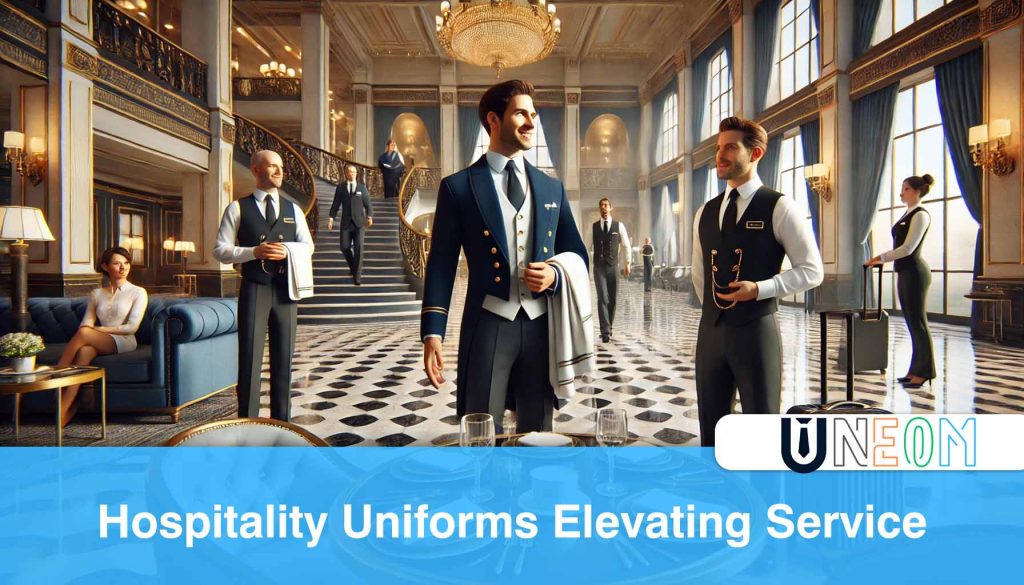
Hospitality Uniforms Brands
Choosing the right brand for hospitality uniforms is crucial for ensuring quality, durability, and style. Several brands specialize in hospitality uniforms, offering a wide range of options tailored to different segments of the industry.
Top Hospitality Uniform Brands
- Cintas
- Renowned for their extensive range of uniforms and exceptional customer service.
- Offers customizable options to align with specific brand requirements.
- UniFirst
- Known for high-quality fabrics and durable designs suitable for demanding hospitality environments.
- Provides comprehensive uniform management solutions, including laundering and maintenance services.
- Chef Works
- Specializes in culinary uniforms, offering stylish and functional attire for kitchen staff.
- Combines fashion-forward designs with practicality, ensuring comfort during long shifts.
- Tru by Hilton
- Exclusive uniform line designed for Hilton’s global properties.
- Emphasizes elegance and sophistication, reflecting Hilton’s brand standards.
- Red Kap
- Offers a diverse range of hospitality uniforms with a focus on durability and comfort.
- Provides options for various roles, from housekeeping to front desk staff.
- American Eagle Outfitters
- Provides trendy and modern uniform options for casual hospitality settings.
- Focuses on youthful and vibrant designs that appeal to a broad demographic.
Factors to Consider When Choosing a Brand
- Quality of Materials: Ensure the brand uses high-quality, durable fabrics that withstand frequent washing and active use.
- Customization Options: Look for brands that offer customizable features such as embroidery, color selection, and logo placement.
- Compliance with Industry Standards: The uniforms should meet the specific requirements and standards of the hospitality industry.
- Cost-Effectiveness: Balance quality with affordability to ensure value for money without compromising on standards.
- Customer Support: Reliable customer service is essential for addressing any issues related to uniform orders, alterations, or replacements.
Hospitality Uniforms Female
Female hospitality uniforms are designed to combine functionality with style, ensuring comfort and professionalism. These uniforms cater to the diverse roles women play in the hospitality industry, from front desk staff to housekeeping and culinary positions.
Key Features of Female Hospitality Uniforms
- Fit and Comfort: Tailored to accommodate different body types while ensuring ease of movement.
- Modesty and Professionalism: Designs that respect cultural and professional standards, often incorporating modest cuts and appropriate hemlines.
- Versatility: Uniforms that can be adapted for various roles, incorporating features like adjustable waistbands, stretch fabrics, and multi-functional pockets.
- Aesthetic Appeal: Stylish elements such as tailored jackets, elegant blouses, and coordinated color schemes that enhance the overall appearance of the staff.
Popular Styles
- Front Desk and Concierge
- Blazers and Blouses: Crisp blazers paired with smart blouses, often in neutral or brand-specific colors.
- Skirts and Trousers: Tailored skirts or trousers that allow for professional movement and comfort.
- Housekeeping and Maintenance
- Comfortable Tops: Breathable shirts with practical features like pockets for tools and cleaning supplies.
- Durable Bottoms: Sturdy pants or skirts designed for ease of movement and durability.
- Culinary Staff
- Chef Jackets: Functional and stylish jackets that offer protection and a professional look.
- Aprons and Accessories: Practical accessories that complement the overall uniform while serving functional purposes.
Trends in Female Hospitality Uniforms
- Sustainable Fabrics: Increasing use of eco-friendly materials to promote sustainability within the industry.
- Inclusive Sizing: Brands are offering a wider range of sizes to accommodate all body types, ensuring comfort and fit for every employee.
- Personalization: Customizable elements such as name tags, embroidered logos, and personalized colors to reflect individual roles and brand identity.
- Modern Cuts: Incorporating contemporary fashion trends while maintaining professional standards, such as slim-fit blazers and high-waisted trousers.
Modern Hospitality Uniforms
Modern hospitality uniforms blend traditional professionalism with contemporary fashion trends, creating attire that is both functional and aesthetically pleasing. These uniforms are designed to meet the evolving demands of the hospitality industry, emphasizing comfort, style, and brand alignment.
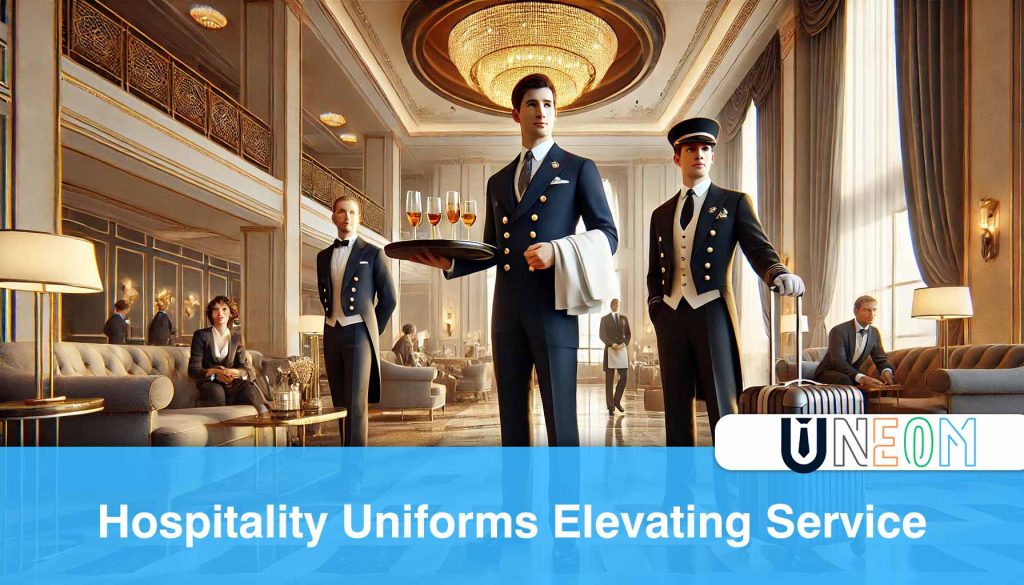
Characteristics of Modern Hospitality Uniforms
- Innovative Fabrics: Use of advanced materials that offer benefits like moisture-wicking, wrinkle resistance, and enhanced durability.
- Ergonomic Design: Focus on comfort and mobility, allowing staff to perform their duties efficiently without restrictions.
- Stylish Elements: Incorporation of modern design elements such as asymmetrical cuts, unique color palettes, and stylish accessories.
- Technology Integration: Features like RFID tags for inventory management and smart textiles that adapt to temperature changes.
Examples of Modern Uniform Designs
- Minimalist Aesthetics
- Clean lines and simple color schemes that project a sleek and professional image.
- Functional designs with minimal embellishments, focusing on practicality and comfort.
- Bold Colors and Patterns
- Use of vibrant colors and unique patterns to create a distinctive and memorable brand presence.
- Strategic use of color blocking and accent pieces to highlight specific areas of the uniform.
- Layered Outfits
- Multi-layered uniforms that allow for adaptability in different settings and weather conditions.
- Incorporation of versatile pieces like vests, cardigans, and scarves that can be added or removed as needed.
- Tech-Enhanced Uniforms
- Integration of smart fabrics that regulate temperature and provide additional comfort.
- Wearable technology embedded in uniforms for enhanced functionality and convenience.
Benefits of Modern Uniforms
- Enhanced Professionalism: Contemporary designs convey a modern and forward-thinking brand image.
- Improved Employee Morale: Stylish and comfortable uniforms contribute to higher employee satisfaction and morale.
- Increased Efficiency: Ergonomically designed uniforms enhance staff productivity by providing comfort and ease of movement.
- Brand Differentiation: Unique and modern designs help in distinguishing the brand from competitors, making it more memorable to guests.
Hospitality Uniforms Catalogue
A comprehensive hospitality uniforms catalogue serves as a valuable resource for hotels, restaurants, and other hospitality establishments looking to outfit their staff. It showcases a wide range of uniform options, allowing decision-makers to select designs that best align with their brand identity and operational needs.
Key Components of a Uniform Catalogue
- Variety of Styles: A diverse selection of uniform styles catering to different roles within the hospitality industry, including front desk, housekeeping, culinary, and maintenance.
- Detailed Descriptions: Clear descriptions of each uniform option, highlighting features such as fabric type, design elements, and available sizes.
- High-Quality Images: Professional images that provide a clear visual representation of each uniform, helping decision-makers visualize how they will look in real settings.
- Customization Options: Information on available customization services, including embroidery, color selection, and logo placement.
- Pricing Information: Transparent pricing details that help establishments budget effectively for uniform purchases.
How to Use a Uniform Catalogue
- Identify Needs: Assess the specific uniform requirements for different roles within the establishment.
- Browse Selections: Explore the variety of styles and options available in the catalogue, paying attention to design features and functionality.
- Evaluate Quality: Review the fabric types and construction quality to ensure the uniforms meet durability and comfort standards.
- Customize: Select customization options that align with the brand’s identity, such as color schemes and logo placement.
- Order Samples: If possible, order samples to evaluate the fit and quality before making bulk purchases.
- Finalize Selection: Choose the best uniform options based on functionality, aesthetics, and budget considerations.
Benefits of a Uniform Catalogue
- Streamlined Decision-Making: A well-organized catalogue simplifies the selection process, making it easier to compare different options.
- Informed Choices: Detailed information helps in making informed decisions regarding fabric quality, design features, and customization needs.
- Cost Efficiency: Transparent pricing allows for better budget management and cost-effective purchasing.
- Brand Consistency: Ensures that all uniform choices align with the brand’s image and standards, promoting a cohesive appearance among staff.
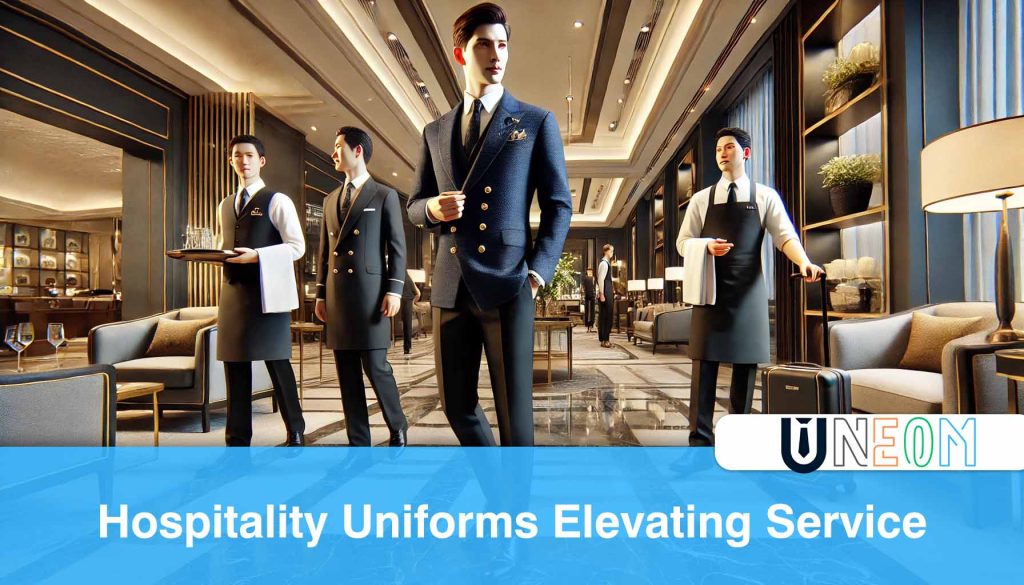
Example of a Hospitality Uniform Catalogue
While specific catalogues vary by brand, a typical hospitality uniform catalogue might include sections such as:
- Front Office Uniforms: Blazers, shirts, skirts, trousers, and accessories.
- Housekeeping Uniforms: Comfortable tops, durable bottoms, aprons, and footwear.
- Culinary Uniforms: Chef jackets, aprons, hats, and non-slip shoes.
- Maintenance Uniforms: Practical shirts, pants, coveralls, and tool belts.
Hotel Staff Uniform Images
Visual representations of hotel staff uniforms are essential for understanding the design, fit, and overall aesthetic of the uniforms. High-quality images provide a realistic preview of how uniforms will look in a professional setting, aiding in the decision-making process.
Importance of Uniform Images
- Visual Clarity: Helps in assessing the color, style, and fit of uniforms before making a purchase.
- Brand Representation: Ensures that the uniforms align with the hotel’s brand image and aesthetic.
- Quality Assurance: Allows decision-makers to evaluate the craftsmanship and material quality through detailed visuals.
- Customization Preview: Facilitates visualization of customization options such as logo placement, embroidery, and color variations.
Types of Uniform Images
- Individual Shots: Detailed images of individual uniform pieces, showcasing fabric texture, design elements, and color accuracy.
- Full Outfit Images: Comprehensive views of complete uniform ensembles, illustrating how different pieces work together.
- Staff in Action: Photos of hotel staff wearing the uniforms in real-life scenarios, providing context on how the uniforms perform during daily operations.
- 360-Degree Views: Interactive images that allow users to rotate and view uniforms from multiple angles, enhancing the evaluation process.
Where to Find Hotel Staff Uniform Images
- Uniform Brand Websites: Most reputable uniform brands provide extensive image galleries in their catalogues or product pages.
- Sample Requests: Requesting sample images from suppliers can offer a more personalized view of uniform options.
- Trade Shows and Exhibitions: Attending industry events allows for firsthand observation of uniform designs and quality.
- Online Reviews and Testimonials: Customer-uploaded images and reviews can provide additional perspectives on uniform appearance and functionality.
Tips for Evaluating Uniform Images
- Check for Detail: Ensure images provide clear and detailed views of the uniform’s design features and fabric quality.
- Assess Fit and Proportion: Look for images that showcase how the uniform fits different body types and the overall proportion of the attire.
- Color Accuracy: Verify that the colors in the images match the actual uniform colors to avoid discrepancies upon delivery.
- Functionality: Evaluate how practical and functional the uniform design is, considering the specific needs of different roles within the hotel.
for more: security uniforms
Luxury Hospitality Uniforms
Luxury hospitality uniforms are designed to reflect the opulence and high standards associated with premium establishments. These uniforms emphasize elegance, sophistication, and meticulous attention to detail, ensuring that staff members exude a sense of refinement and professionalism.
Characteristics of Luxury Hospitality Uniforms
- High-Quality Fabrics: Use of premium materials such as silk, satin, and high-grade cotton that offer a luxurious feel and superior durability.
- Elegant Designs: Sophisticated cuts and tailored fits that enhance the staff’s appearance and convey a sense of exclusivity.
- Refined Detailing: Intricate embellishments such as embroidery, lace, and custom buttons that add a touch of elegance to the uniform.
- Sophisticated Color Palettes: Use of rich and subdued colors like black, navy, burgundy, and gold that exude sophistication and complement the establishment’s ambiance.
Examples of Luxury Uniform Designs
- Concierge and Front Desk Staff
- Tailored Blazers: Fitted blazers with elegant lapels and high-quality buttons.
- Silk Blouses: Soft, flowing blouses that add a touch of elegance to the uniform.
- Tailored Trousers or Skirts: Perfectly tailored trousers or pencil skirts that offer a polished and professional look.
- Housekeeping and Maintenance
- Premium Shirts and Blouses: Shirts made from high-quality fabrics with refined detailing.
- Elegant Aprons: Stylish aprons with subtle embellishments that maintain a professional appearance.
- Comfortable yet Stylish Footwear: High-quality, comfortable shoes that provide both functionality and style.
- Culinary Staff
- Luxury Chef Jackets: Jackets made from premium fabrics with elegant cuts and sophisticated detailing.
- Stylish Hats and Accessories: Chef hats and accessories that complement the overall luxurious appearance of the uniform.
- High-Quality Aprons: Durable yet stylish aprons that maintain a refined look even in a busy kitchen environment.
Benefits of Luxury Uniforms
- Enhanced Brand Image: Reflects the establishment’s commitment to excellence and high standards.
- Improved Staff Morale: High-quality, stylish uniforms contribute to staff pride and confidence.
- Guest Perception: Guests perceive the establishment as upscale and professional, enhancing their overall experience.
- Durability and Longevity: Premium fabrics and construction ensure that luxury uniforms withstand frequent use and maintain their appearance over time.
Customization in Luxury Uniforms
- Embroidery and Logos: Custom embroidery and logo placement add a personalized touch, reinforcing brand identity.
- Unique Design Elements: Incorporating unique design elements such as custom buttons, monogrammed initials, and distinctive patterns.
- Tailored Fits: Offering bespoke tailoring options to ensure that each uniform fits perfectly, enhancing the overall appearance of the staff.
Uniforms Hotel
Hotel uniforms are a crucial aspect of the overall guest experience, serving as a visual representation of the hotel’s brand and standards. Well-designed hotel uniforms enhance the professional appearance of staff, promote brand consistency, and contribute to a positive guest perception.
Types of Hotel Uniforms
- Front Desk and Concierge
- Sophisticated Blazers and Trousers: Professional and polished attire that reflects the hotel’s high standards.
- Smart Accessories: Items such as ties, scarves, and belts that complement the uniform and add a touch of elegance.
- Housekeeping and Maintenance
- Comfortable and Practical Attire: Uniforms designed for ease of movement and functionality, with durable fabrics and practical features like pockets.
- Protective Gear: Specialized uniforms that offer protection and durability, especially for maintenance staff.
- Culinary Staff
- Chef Jackets and Aprons: Functional and stylish uniforms that provide protection and a professional appearance.
- Comfortable Footwear: Non-slip and comfortable shoes designed to withstand long hours in the kitchen.
- Food and Beverage Staff
- Elegant Attire: Uniforms that reflect the dining environment, whether casual or fine dining, with attention to detail and style.
- Practical Design: Features like stain-resistant fabrics and easy-care materials to maintain a pristine appearance.
Importance of Hotel Uniforms
- Brand Representation: Uniforms are a key element in conveying the hotel’s brand image and values.
- Professionalism: A well-coordinated uniform enhances the professional appearance of staff, instilling confidence in guests.
- Consistency: Uniforms ensure a consistent look across all staff members, reinforcing the hotel’s standards and identity.
- Guest Comfort and Trust: Guests feel more comfortable and trusting when they can easily identify and approach well-presented staff.
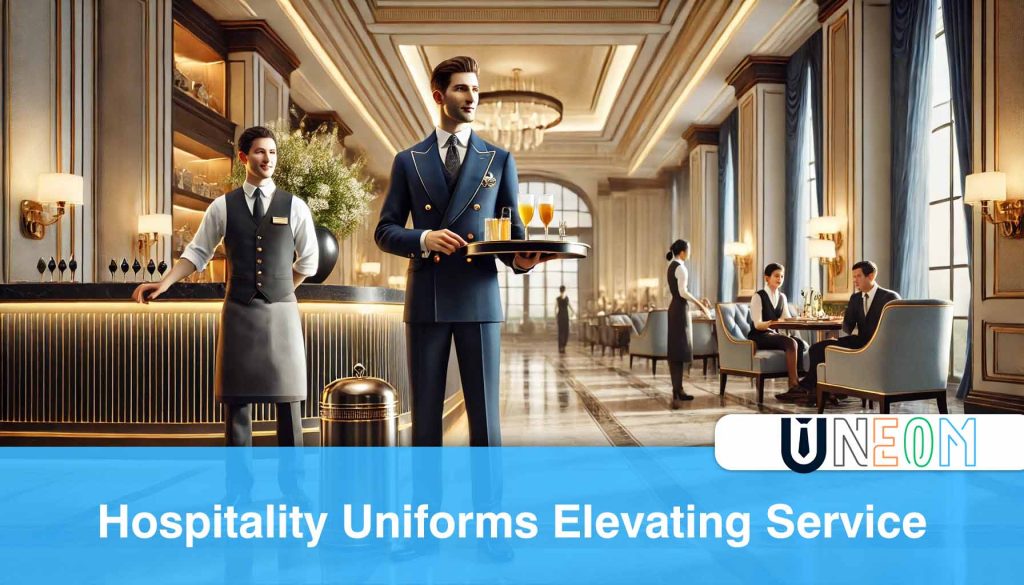
Selecting the Right Uniforms for Your Hotel
- Understand Your Brand: The uniform design should align with the hotel’s brand identity, whether it’s luxury, modern, traditional, or casual.
- Consider Functionality: Ensure that uniforms are practical for the specific roles and duties of the staff, providing comfort and ease of movement.
- Prioritize Quality: Invest in high-quality fabrics and construction to ensure durability and a long-lasting appearance.
- Incorporate Feedback: Gather input from staff members to understand their needs and preferences, ensuring that uniforms are both stylish and functional.
Maintenance and Care
- Regular Cleaning: Implement a consistent cleaning schedule to maintain the appearance and hygiene of the uniforms.
- Proper Storage: Store uniforms in a manner that preserves their shape and prevents damage.
- Repairs and Replacements: Address any wear and tear promptly to ensure that uniforms remain in excellent condition.
Hotel Uniform Design
Designing hotel uniforms involves a careful balance between aesthetics, functionality, and brand alignment. The design process considers various factors to ensure that uniforms not only look professional but also meet the practical needs of the staff.
Key Elements of Hotel Uniform Design
- Color Scheme
- Brand Colors: Incorporating the hotel’s brand colors to reinforce brand identity and create a cohesive look.
- Neutral and Elegant Tones: Using colors that convey professionalism and elegance, such as black, white, navy, and grey.
- Accent Colors: Adding subtle accent colors to highlight specific design elements and add visual interest.
- Fabric Selection
- Durability: Choosing fabrics that withstand frequent washing and active use, such as polyester blends and high-quality cotton.
- Comfort: Selecting breathable and lightweight materials to ensure staff comfort throughout their shifts.
- Wrinkle Resistance: Opting for fabrics that maintain a neat appearance, even after extended wear.
- Fit and Silhouette
- Tailored Fits: Designing uniforms that are well-fitted to enhance the professional appearance of staff.
- Ergonomic Design: Ensuring that uniforms allow for ease of movement and do not restrict staff during their duties.
- Gender-Inclusive Designs: Creating uniform options that cater to different body types and gender-specific needs.
- Functional Features
- Pockets: Incorporating practical pockets for carrying essential items like keys, notepads, and pens.
- Adjustable Elements: Features like adjustable waistbands and cuffs to accommodate different body sizes and preferences.
- Layering Options: Providing options for layering, such as cardigans, vests, and jackets, to adapt to different environments and weather conditions.
- Branding and Customization
- Logos and Embroidery: Strategically placing the hotel’s logo and name on uniforms to enhance brand visibility.
- Unique Design Elements: Adding distinctive features like custom buttons, badges, and accessories to create a unique and recognizable uniform.
Design Process for Hotel Uniforms
- Concept Development
- Collaborate with hotel management to understand brand values, aesthetic preferences, and specific requirements.
- Develop design concepts that reflect the hotel’s identity and meet functional needs.
- Material Selection
- Choose appropriate fabrics based on durability, comfort, and aesthetic considerations.
- Ensure that materials align with the hotel’s sustainability goals, if applicable.
- Prototyping and Sampling
- Create prototypes of uniform designs to evaluate fit, comfort, and overall appearance.
- Gather feedback from staff members and management to refine the designs.
- Final Design Approval
- Make necessary adjustments based on feedback and finalize the uniform designs.
- Ensure that all design elements align with the hotel’s brand standards and functional requirements.
- Production and Distribution
- Proceed with the production of uniforms, ensuring quality control at every stage.
- Distribute uniforms to staff members, providing guidelines on proper care and maintenance.
Trends in Hotel Uniform Design
- Sustainable Practices: Increasing use of eco-friendly materials and ethical production methods in uniform design.
- Tech-Enhanced Uniforms: Incorporation of smart fabrics and wearable technology to enhance functionality and comfort.
- Minimalist Designs: Simplistic and clean designs that emphasize elegance and professionalism.
- Cultural Integration: Incorporating elements that reflect local culture and heritage, enhancing the authenticity of the guest experience.
- Personalization: Customizable features that allow for individual expression while maintaining brand consistency.
Uniform for Housemaid
Housemaid uniforms are designed to provide comfort, functionality, and a professional appearance. These uniforms cater to the specific tasks performed by housemaids, ensuring that they can perform their duties efficiently while maintaining a neat and consistent appearance.
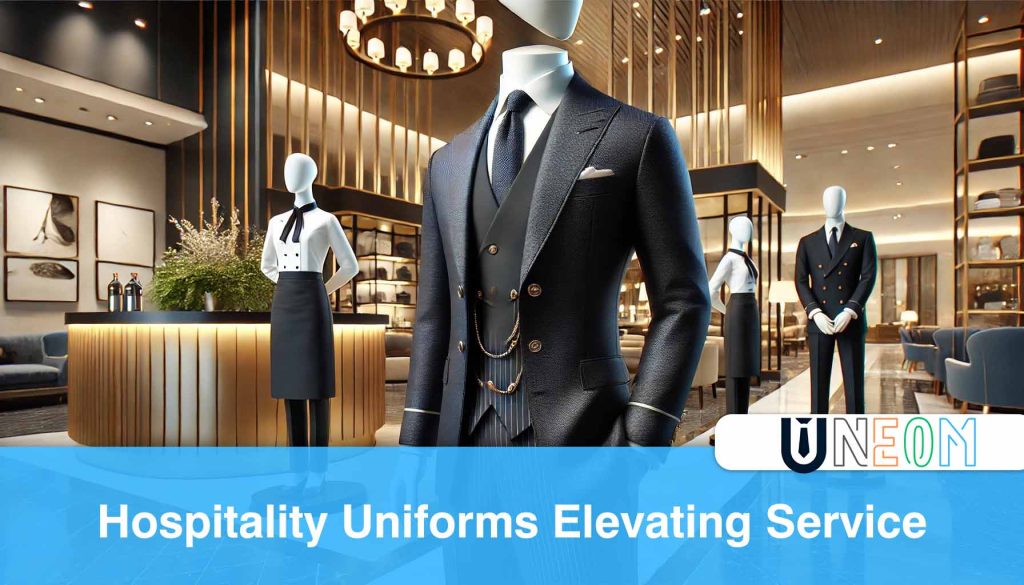
Key Features of Housemaid Uniforms
- Comfortable Fabrics: Use of breathable and lightweight materials that allow for ease of movement during daily tasks.
- Practical Design: Features like aprons, pockets, and durable stitching to accommodate the physical demands of housekeeping duties.
- Easy Maintenance: Fabrics that are easy to clean and resistant to stains, ensuring that uniforms remain presentable with minimal effort.
- Modest and Professional Appearance: Designs that respect cultural norms and present a professional image to guests.
Common Styles
- Traditional Housemaid Uniforms
- Long-Sleeved Tops: Simple, modest tops that provide coverage and a clean appearance.
- Full-Length Aprons: Durable aprons that protect clothing and provide additional storage for tools and supplies.
- Comfortable Bottoms: Practical skirts or trousers that allow for unrestricted movement.
- Modern Housemaid Uniforms
- Functional Dresses: Dresses designed for ease of movement, often with built-in aprons or pockets.
- Short-Sleeved Shirts: Lightweight shirts suitable for warmer climates or active duties.
- Smart Accessories: Items like belts, name tags, and comfortable footwear that enhance the overall appearance.
Benefits of Proper Housemaid Uniforms
- Enhanced Professionalism: Uniforms present a unified and professional image, instilling confidence in guests.
- Improved Efficiency: Practical designs with functional features enable housemaids to perform their tasks more effectively.
- Increased Safety: Proper uniforms can include safety features like non-slip shoes and durable fabrics that protect against workplace hazards.
- Staff Morale: Comfortable and stylish uniforms contribute to higher job satisfaction and morale among housemaids.
Customization Options
- Embroidery and Logos: Adding the hotel’s logo and housemaid’s name for easy identification and brand reinforcement.
- Color Selection: Choosing colors that align with the hotel’s branding while maintaining a professional look.
- Adjustable Features: Incorporating adjustable waistbands, cuffs, and hemlines to accommodate different body types and preferences.
Maintenance and Care
- Regular Washing: Implementing a consistent laundry schedule to keep uniforms clean and presentable.
- Proper Storage: Ensuring that uniforms are stored in a way that preserves their shape and prevents damage.
- Repairs and Replacements: Promptly addressing any wear and tear to maintain a neat and professional appearance.
Uniform for Housekeeper
Uniforms for housekeepers are similar to those for housemaids but may include additional features tailored to the specific responsibilities and environments of housekeeping staff. These uniforms prioritize comfort, functionality, and durability to support the demanding nature of housekeeping duties.
Key Features of Housekeeper Uniforms
- Durable Fabrics: Strong materials that withstand frequent washing and active use, ensuring longevity.
- Functional Design: Features like multiple pockets for carrying cleaning supplies and tools.
- Comfort and Mobility: Ergonomically designed uniforms that allow for easy movement and reduce fatigue.
- Professional Appearance: Clean and modest designs that present a polished and trustworthy image to guests.
Common Styles
- Classic Housekeeper Uniforms
- Polo Shirts: Comfortable and breathable shirts that provide ease of movement.
- Cargo Pants or Skirts: Practical bottoms with ample pocket space for carrying essential items.
- Aprons: Protective aprons that keep clothing clean and provide additional storage.
- Modern Housekeeper Uniforms
- Performance Fabrics: Use of moisture-wicking and wrinkle-resistant materials for enhanced comfort.
- Stylish Cuts: Contemporary designs with tailored fits and stylish elements like contrasting seams or accent colors.
- Smart Accessories: Functional accessories like belts, badges, and non-slip shoes that enhance both functionality and appearance.
Benefits of Proper Housekeeper Uniforms
- Efficiency in Duties: Functional designs with practical features enable housekeepers to perform their tasks more efficiently.
- Safety and Protection: Durable fabrics and protective features safeguard against potential workplace hazards.
- Professional Image: Consistent and professional uniforms enhance the overall image of the hotel and instill trust in guests.
- Employee Comfort: Comfortable and well-fitted uniforms contribute to higher job satisfaction and reduce fatigue.
Customization Options
- Color Coordination: Selecting colors that align with the hotel’s branding while ensuring visibility and professionalism.
- Logo Embroidery: Adding the hotel’s logo to uniforms for brand reinforcement and easy identification.
- Adjustable Features: Incorporating adjustable elements to ensure a comfortable fit for all staff members.
Maintenance and Care
- Consistent Cleaning: Implementing a regular laundry schedule to maintain cleanliness and hygiene.
- Proper Handling: Training staff on how to care for their uniforms to prolong their lifespan.
- Repairs and Upkeep: Addressing any damages promptly to ensure uniforms remain in good condition.
Uniform for Hospitality Industry
Uniforms in the hospitality industry extend beyond hotels and restaurants to include a wide range of establishments such as resorts, spas, cruise ships, and event venues. Each sector within the hospitality industry has unique uniform requirements that cater to specific roles and operational needs.
Diverse Roles in the Hospitality Industry
- Front Office and Concierge
- Responsible for guest check-ins, inquiries, and providing information about the hotel and local attractions.
- Uniforms should convey professionalism, approachability, and brand consistency.
- Housekeeping and Maintenance
- Responsible for maintaining cleanliness and functionality within the establishment.
- Uniforms need to be practical, comfortable, and designed for active movement.
- Culinary and Food Service
- Includes chefs, kitchen staff, waitstaff, and bartenders who prepare and serve food and beverages.
- Uniforms should balance functionality with a stylish appearance, reflecting the establishment’s dining environment.
- Recreation and Spa Staff
- Includes fitness trainers, spa therapists, and recreational activity coordinators.
- Uniforms should be comfortable, flexible, and suitable for physical activities.
- Event and Banquet Staff
- Responsible for organizing and managing events, conferences, and banquets.
- Uniforms should be elegant and professional, reflecting the formality of events.
Uniform Design Considerations for the Hospitality Industry
- Role-Specific Features: Tailoring uniforms to meet the specific needs and functions of different roles within the industry.
- Durability and Maintenance: Selecting fabrics and designs that can withstand the demands of the job and frequent washing.
- Brand Alignment: Ensuring that all uniform designs align with the overall brand identity and standards of the establishment.
- Comfort and Mobility: Prioritizing comfort and ease of movement to enhance staff performance and reduce fatigue.
- Aesthetic Appeal: Balancing functionality with style to create a visually appealing and professional look.
Benefits of Well-Designed Uniforms in the Hospitality Industry
- Enhanced Guest Experience: Professional and cohesive uniforms contribute to a positive and memorable guest experience.
- Improved Staff Morale: Comfortable and stylish uniforms boost staff confidence and job satisfaction.
- Brand Consistency: Uniforms help in maintaining a consistent brand image across all touchpoints within the establishment.
- Operational Efficiency: Functional designs facilitate efficient performance of duties, enhancing overall operational effectiveness.
Customization and Personalization
- Tailored Fits: Offering customized fits to ensure uniforms are comfortable and flattering for all staff members.
- Unique Design Elements: Incorporating unique design elements that reflect the establishment’s personality and brand.
- Personal Identification: Adding personal identifiers such as name tags, badges, and embroidered names to promote a sense of ownership and accountability among staff.
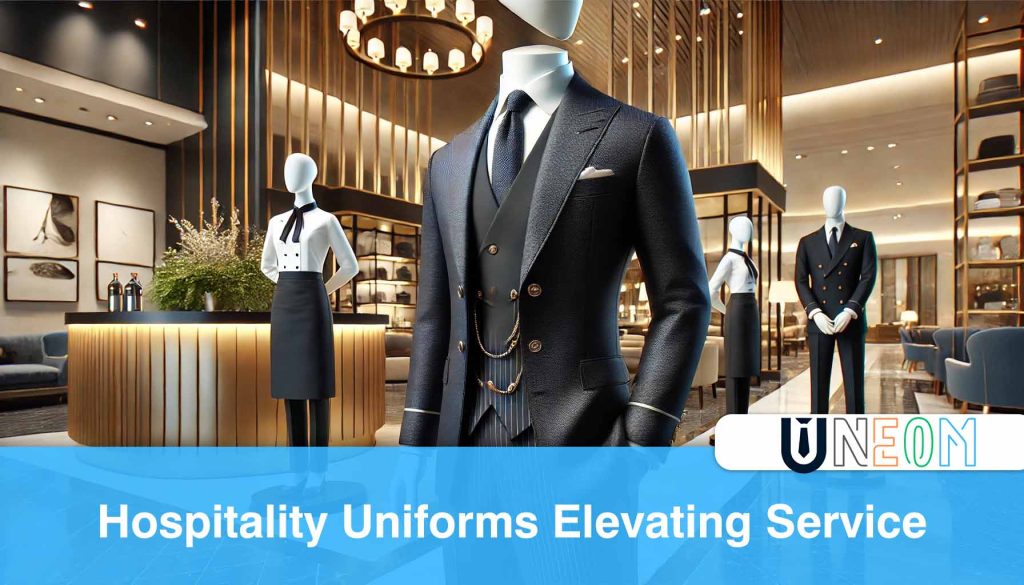
Uniform of Hotel Staff
The uniforms of hotel staff encompass a wide range of roles, each requiring specific designs and features to meet the demands of their duties. From front desk personnel to housekeeping and culinary staff, each uniform is tailored to enhance the professionalism and efficiency of the staff while aligning with the hotel’s brand identity.
Front Desk and Concierge Uniforms
- Design Elements: Crisp blazers, tailored trousers or skirts, smart shirts or blouses, and polished footwear.
- Functional Features: Pockets for essential items, comfortable fabrics for long shifts, and easy-care materials for frequent washing.
- Brand Alignment: Incorporating the hotel’s colors and logo to reinforce brand identity and ensure consistency across all staff members.
Housekeeping Uniforms
- Design Elements: Comfortable tops, durable bottoms, protective aprons, and non-slip shoes.
- Functional Features: Multiple pockets for carrying cleaning supplies and tools, breathable fabrics for comfort during physical tasks, and stain-resistant materials for easy maintenance.
- Durability: High-quality fabrics that withstand frequent washing and active use, ensuring longevity and consistent appearance.
Culinary Staff Uniforms
- Design Elements: Chef jackets, aprons, chef hats, and non-slip shoes.
- Functional Features: Breathable and moisture-wicking fabrics to keep staff cool in hot kitchen environments, reinforced stitching for durability, and practical designs that facilitate ease of movement.
- Safety Considerations: Uniforms designed to protect against spills, burns, and other kitchen hazards, ensuring staff safety and hygiene.
Maintenance Staff Uniforms
- Design Elements: Sturdy shirts, durable pants, protective gear, and comfortable footwear.
- Functional Features: Pockets for tools and supplies, flexible fabrics for ease of movement, and reinforced areas for added durability.
- Safety Features: High-visibility elements, non-slip soles, and protective materials to ensure safety during maintenance tasks.
Food and Beverage Staff Uniforms
- Design Elements: Elegant attire such as smart shirts, aprons, vests, and stylish footwear.
- Functional Features: Stain-resistant fabrics, comfortable fits for long hours of standing and serving, and practical designs that facilitate efficient service.
- Aesthetic Appeal: Uniforms that reflect the dining environment, whether casual or fine dining, enhancing the overall guest experience.
Importance of Uniform Consistency
- Professional Image: Consistent uniforms across all staff members present a unified and professional image to guests.
- Brand Recognition: Uniform consistency reinforces brand identity, making it easier for guests to recognize and associate the uniform with the establishment.
- Operational Efficiency: Uniforms designed for specific roles enhance staff efficiency by providing functional features that support their duties.
Unique Hospitality Company
In an industry as competitive as hospitality, standing out is essential for success. Unique hospitality companies distinguish themselves through exceptional service, innovative offerings, and distinctive branding. One key aspect that contributes to this uniqueness is the design and implementation of distinctive hospitality uniforms.
Characteristics of a Unique Hospitality Company
- Innovative Service Offerings: Providing unique services or experiences that set the company apart from competitors.
- Distinctive Branding: Creating a strong and memorable brand identity through logo design, color schemes, and marketing strategies.
- Exceptional Customer Service: Prioritizing guest satisfaction and exceeding expectations through personalized and attentive service.
- Sustainable Practices: Embracing eco-friendly and sustainable practices to appeal to environmentally conscious guests.
Role of Uniforms in Creating Uniqueness
- Distinctive Designs: Developing unique uniform designs that reflect the company’s brand and ethos, setting the staff apart from competitors.
- Custom Branding Elements: Incorporating unique branding elements such as custom embroidery, unique color palettes, and personalized accessories.
- Personalization: Offering personalized uniform options that cater to individual roles and preferences, enhancing the overall guest experience.
- Cohesive Look: Ensuring that all uniform elements work together to create a cohesive and distinctive appearance that aligns with the company’s branding.
Examples of Unique Uniform Designs
- Themed Uniforms
- Uniforms designed around specific themes or concepts that reflect the company’s unique identity and service offerings.
- Examples include uniforms inspired by local culture, historical periods, or specific design aesthetics.
- Innovative Materials and Technologies
- Use of advanced fabrics and technologies to enhance comfort, functionality, and sustainability.
- Incorporating features like smart textiles, moisture-wicking materials, and eco-friendly fabrics.
- Custom Accessories
- Unique accessories such as custom badges, branded scarves, or distinctive footwear that add a personalized touch to the uniforms.
- Incorporation of accessories that enhance the overall aesthetic and functionality of the uniform.
Benefits of Unique Uniforms for Hospitality Companies
- Brand Differentiation: Distinctive uniforms help in differentiating the company from competitors, making it more memorable to guests.
- Enhanced Guest Experience: Unique and stylish uniforms contribute to a positive and memorable guest experience, fostering brand loyalty.
- Employee Pride: Staff members feel proud and confident wearing unique uniforms that reflect their company’s identity and values.
- Increased Visibility: Unique uniforms enhance brand visibility, making it easier for guests to identify and remember the company.
Case Studies of Unique Hospitality Uniforms
- Boutique Hotels
- Boutique hotels often use unique uniform designs that reflect their individualized service and distinctive ambiance.
- Example: A boutique hotel might use vintage-inspired uniforms that align with its historic setting and personalized service approach.
- Luxury Resorts
- Luxury resorts invest in high-end, bespoke uniform designs that convey opulence and exclusivity.
- Example: Staff uniforms might include tailored suits, silk blouses, and elegant accessories to match the resort’s upscale environment.
- Eco-Friendly Establishments
- Eco-friendly hotels and resorts prioritize sustainable uniform designs that align with their environmental values.
- Example: Uniforms made from organic cotton, recycled materials, and eco-friendly dyes to promote sustainability.
Creating a Unique Uniform Strategy
- Define Brand Identity
- Clearly articulate the company’s brand values, mission, and aesthetic to guide uniform design decisions.
- Collaborate with Designers
- Work with professional uniform designers who understand the company’s vision and can create bespoke uniform solutions.
- Incorporate Feedback
- Gather input from staff and management to ensure that uniforms meet both aesthetic and functional needs.
- Implement Consistently
- Ensure uniform consistency across all staff members to maintain a cohesive and professional appearance.
- Evolve with Trends
- Stay updated with design trends and continuously refine uniform designs to keep them modern and relevant.
Uniforms for House Maids
Uniforms for house maids are an essential component of maintaining the cleanliness and orderliness of hospitality establishments. These uniforms are designed to provide functionality, comfort, and a professional appearance, ensuring that house maids can perform their duties efficiently while representing the establishment’s brand positively.
Key Features of House Maids’ Uniforms
- Comfortable and Breathable Fabrics: Use of materials that allow for ease of movement and comfort during long shifts.
- Functional Design: Incorporation of practical features such as multiple pockets for carrying cleaning supplies and tools.
- Durability: Sturdy fabrics that withstand frequent washing and active use, ensuring longevity.
- Professional Appearance: Clean and modest designs that present a neat and organized image to guests.
Common Styles
- Traditional Uniforms
- Aprons and Dresses: Classic designs that include aprons and dresses, providing a modest and professional look.
- Comfortable Shoes: Non-slip and comfortable footwear designed for active work environments.
- Modern Uniforms
- Casual Shirts and Trousers: Lightweight and breathable shirts paired with practical trousers for a more relaxed yet professional appearance.
- Stylish Accessories: Incorporation of stylish elements such as belts, name tags, and branded accessories to enhance the overall look.
Benefits of Proper House Maids’ Uniforms
- Enhanced Professionalism: Uniforms create a unified and professional image, instilling trust and confidence in guests.
- Improved Efficiency: Functional designs with practical features enable house maids to perform their tasks more efficiently.
- Safety and Protection: Durable and protective uniforms safeguard against workplace hazards and maintain hygiene standards.
- Staff Morale: Comfortable and stylish uniforms contribute to higher job satisfaction and morale among house maids.
Customization Options
- Color Selection: Choosing colors that align with the establishment’s branding while ensuring a professional appearance.
- Logo Embroidery: Adding the hotel’s logo to uniforms for brand reinforcement and easy identification.
- Adjustable Features: Incorporating adjustable elements to ensure a comfortable fit for all staff members.
Maintenance and Care
- Regular Cleaning: Implementing a consistent laundry schedule to maintain cleanliness and hygiene.
- Proper Handling: Training staff on how to care for their uniforms to prolong their lifespan.
- Repairs and Upkeep: Promptly addressing any damages to ensure uniforms remain in good condition.
Role of Uniforms in Housekeeping
- Visibility and Identification: Uniforms make house maids easily identifiable to guests, facilitating better communication and service.
- Brand Representation: House maids’ uniforms reflect the establishment’s brand values and standards, enhancing the overall guest experience.
- Operational Efficiency: Well-designed uniforms support the practical aspects of housekeeping duties, improving efficiency and effectiveness.
Conclusion
Hospitality uniforms are a vital element in the success of any establishment within the industry. They not only enhance the professional appearance of staff but also play a crucial role in brand representation, operational efficiency, and guest satisfaction. From selecting the right brands and designs to ensuring functionality and comfort, every aspect of hospitality uniforms must be meticulously considered to meet the diverse needs of the industry.
Key Takeaways
- Brand Alignment: Uniforms should reflect the establishment’s brand identity, values, and aesthetic.
- Functionality and Comfort: Designs must balance style with practicality, ensuring staff can perform their duties efficiently and comfortably.
- Customization and Personalization: Tailoring uniforms to meet specific role requirements and brand standards enhances the overall guest experience.
- Quality and Durability: Investing in high-quality fabrics and construction ensures that uniforms withstand the demands of the hospitality industry.
- Consistency: Uniform consistency across all staff members fosters a cohesive and professional image, reinforcing brand identity and guest trust.
By prioritizing the design and implementation of well-crafted hospitality uniforms, establishments can elevate their service standards, enhance their brand image, and create memorable experiences for their guests. Whether you are a boutique hotel, a luxury resort, or a bustling restaurant, the right uniforms can make a significant difference in your operations and overall success.
For those seeking high-quality, customizable hospitality uniforms, partnering with reputable uniform suppliers and designers is essential. They can provide expert guidance, a wide range of options, and tailored solutions that align with your specific needs and brand identity. Investing in the right hospitality uniforms is not just an operational necessity; it’s a strategic decision that can set your establishment apart in the competitive hospitality landscape.



